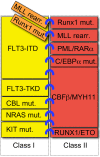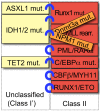Current findings for recurring mutations in acute myeloid leukemia
- PMID: 21917154
- PMCID: PMC3180439
- DOI: 10.1186/1756-8722-4-36
Current findings for recurring mutations in acute myeloid leukemia
Abstract
The development of acute myeloid leukemia (AML) is a multistep process that requires at least two genetic abnormalities for the development of the disease. The identification of genetic mutations in AML has greatly advanced our understanding of leukemogenesis. Recently, the use of novel technologies, such as massively parallel DNA sequencing or high-resolution single-nucleotide polymorphism arrays, has allowed the identification of several novel recurrent gene mutations in AML. The aim of this review is to summarize the current findings for the identification of these gene mutations (Dnmt, TET2, IDH1/2, NPM1, ASXL1, etc.), most of which are frequently found in cytogenetically normal AML. The cooperative interactions of these molecular aberrations and their interactions with class I/II mutations are presented. The prognostic and predictive significances of these aberrations are also reviewed.
Figures



Similar articles
-
Coexisting and cooperating mutations in NPM1-mutated acute myeloid leukemia.Leuk Res. 2017 May;56:7-12. doi: 10.1016/j.leukres.2017.01.027. Epub 2017 Jan 23. Leuk Res. 2017. PMID: 28152414
-
Mutational profiling of acute myeloid leukemia with normal cytogenetics in Brazilian patients: the value of next-generation sequencing for genomic classification.J Investig Med. 2017 Dec;65(8):1155-1158. doi: 10.1136/jim-2017-000566. Epub 2017 Sep 18. J Investig Med. 2017. PMID: 28923882
-
[Using next generation sequencing technology to analyze gene mutations in patients with acute myeloid leukemia and the impact on prognosis].Zhonghua Yi Xue Za Zhi. 2019 Oct 29;99(40):3145-3151. doi: 10.3760/cma.j.issn.0376-2491.2019.40.005. Zhonghua Yi Xue Za Zhi. 2019. PMID: 31694105 Chinese.
-
Genomics of Acute Myeloid Leukemia Diagnosis and Pathways.J Clin Oncol. 2017 Mar 20;35(9):934-946. doi: 10.1200/JCO.2016.71.2208. Epub 2017 Feb 13. J Clin Oncol. 2017. PMID: 28297624 Review.
-
[Identification of novel pathogenic gene mutations in pediatric acute myeloid leukemia by whole-exome resequencing].Rinsho Ketsueki. 2015 Dec;56(12):2419-25. doi: 10.11406/rinketsu.56.2419. Rinsho Ketsueki. 2015. PMID: 26725349 Review. Japanese.
Cited by
-
Selective inhibitors of nuclear export (SINE) in hematological malignancies.Exp Hematol Oncol. 2015 Mar 1;4:7. doi: 10.1186/s40164-015-0002-5. eCollection 2015. Exp Hematol Oncol. 2015. PMID: 25745591 Free PMC article.
-
Evaluating the frequency, prognosis and survival of RUNX1 and ASXL1 mutations in patients with acute myeloid leukaemia in northeastern Iran.J Cell Mol Med. 2022 Jul;26(13):3797-3801. doi: 10.1111/jcmm.17424. Epub 2022 Jun 12. J Cell Mol Med. 2022. PMID: 35692075 Free PMC article.
-
CTNNA1 hypermethylation, a frequent event in acute myeloid leukemia, is independently associated with an adverse outcome.Oncotarget. 2016 May 24;7(21):31454-65. doi: 10.18632/oncotarget.8962. Oncotarget. 2016. PMID: 27129146 Free PMC article.
-
Mutated NPM1 in patients with acute myeloid leukemia in remission and relapse.Leuk Lymphoma. 2014 Jun;55(6):1337-44. doi: 10.3109/10428194.2013.840776. Epub 2013 Oct 9. Leuk Lymphoma. 2014. PMID: 24004182 Free PMC article.
-
Emerging DNA Methylome Targets in FLT3-ITD-Positive Acute Myeloid Leukemia: Combination Therapy with Clinically Approved FLT3 Inhibitors.Curr Treat Options Oncol. 2024 Jun;25(6):719-751. doi: 10.1007/s11864-024-01202-7. Epub 2024 May 2. Curr Treat Options Oncol. 2024. PMID: 38696033 Free PMC article. Review.
References
-
- Byrd JC, Mrozek K, Dodge RK, Carroll AJ, Edwards CG, Arthur DC, Pettenati MJ, Patil SR, Rao KW, Watson MS. et al.Pretreatment cytogenetic abnormalities are predictive of induction success, cumulative incidence of relapse, and overall survival in adult patients with de novo acute myeloid leukemia: results from Cancer and Leukemia Group B (CALGB 8461) Blood. 2002;100:4325–4336. doi: 10.1182/blood-2002-03-0772. - DOI - PubMed
Publication types
MeSH terms
LinkOut - more resources
Full Text Sources
Other Literature Sources
Medical
Miscellaneous

